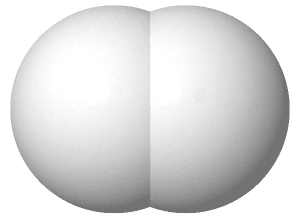Molecular hydrogen

Molecular hydrogen, sometimes called dihydrogen, is a diatomic molecule that is composed of two hydrogen atoms held together by a covalent bond with the chemical formula H2.
Molecular hydrogen is used in the hydrogenation of fats and oils, and sometimes is used for filling balloons. However, molecular hydrogen is quite flammable - it was famously involved in the destruction of the Hindenburg airship in 1937.[2] Liquid H2 is important in the study of superconductivity due to its extremely low temperature. Molecular hydrogen is also used in the production of methanol, in hydrocarbon cracking, and in the production of hydrochloric acid.[3]
Additionally, H2 can be used as a fuel, providing useful energy. To be used as a fuel it requires combustion in the presence of molecular oxygen, which creates heat which can be used for work. The only product of the combustion of hydrogen and oxygen is water. Hydrogen can also be used as an energy currency.
For more information on the more advanced topic of how the study of molecular hydrogen is connected to quantum mechanics, see Hyperphysics.
Properties
Below is a table of some of the basic properties of molecular oxygen.
| Chemical formula | H2 |
| Molar mass | 2.016 g/mol[4] |
| Boiling Point | −259oC[5] |
| Melting Point | −253°C[5] |
References
- ↑ History of the Universe. (July 30, 2015). Molecular Hydrogen [Online]. Available: http://www.historyoftheuniverse.com/images/h2.png
- ↑ Wikipedia. "Hindenburg Disaster" [Online]. Available: https://en.wikipedia.org/wiki/Hindenburg_disaster
- ↑ WebElements. (May 12, 2015). Hydrogen [Online]. Available: https://www.webelements.com/hydrogen/uses.html
- ↑ Web QC. (May 13, 2015). Molar Mass of O2 [Online]. Available: http://www.webqc.org/mmcalc.php
- ↑ 5.0 5.1 Yinon Bentor.(May 12, 2015). Hydrogen [Online]. Available: http://www.chemicalelements.com/elements/h.html

